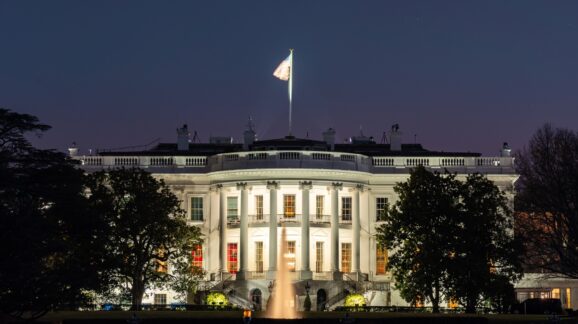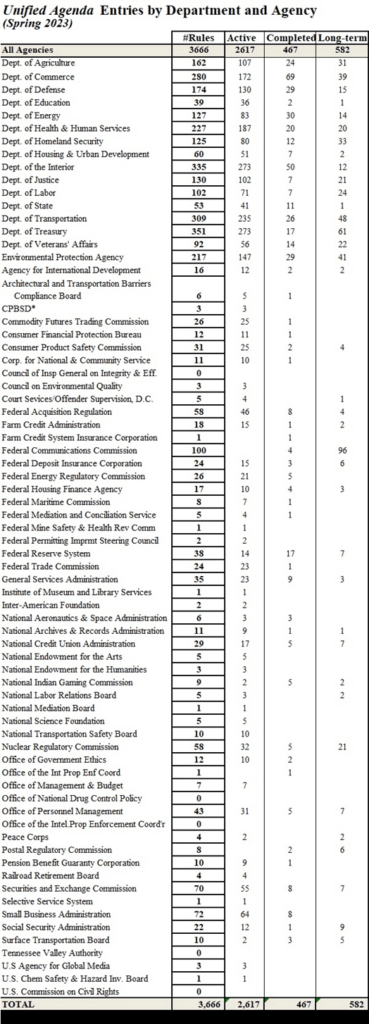New Biden White House Agenda shows 3,666 rules in regulatory pipeline

Photo Credit: Getty
The Spring 2023 Unified Agenda of Federal Regulatory and Deregulatory Actions has been released. A fall version of this twice-yearly document will also contain a “Regulatory Plan.”
Each year since the early 1980s, federal departments and agencies have highlighted priorities in the Agenda, which initially prioritized paperwork reduction, regulatory oversight and the balancing of costs and benefits.
While it’s certainly not beach reading, the Unified Agenda presents a snapshot of active and long-term rules moving through the pipeline, plus a selection of rules newly completed. Political motives and elections, unsurprisingly, can affect prioritization or even reporting itself, affecting the Agenda’s bulk.
This spring Agenda finds slight downticks in acknowledged rules at the Active and Completed stages, but rises in those planned for the longer-term. Finalized rules that fall within the Congressional Review Act window for a resolution of disapproval could be vulnerable if they are completed too late and Biden is not reelected.
As discussed elsewhere, Joe Biden’s “Modernizing Regulatory Review” campaign, recently reiterated in E.O. 14,094, has altered the White House Office of Management and Budget’s stance from one emphasizing supervision to an emphasis on advancing “net benefits” as progressives see them on the likes of equity, climate, environmental and economic regulation. Compounding that, recent legislation on infrastructure, inflation and tech investment are likely to be prolific in their regulatory offspring.
There are considerable transformations between administrations in the goals and focus of the Unified Agenda. The compendium was quite different during Trump’s “one-in, two-out” campaign. Notably, guidance documents, likely to play an increasingly prominent role in these pursuits, get captured in neither the Unified Agenda, the White House Report to Congress on federal regulation, nor even reliably in the Federal Register.
The Agenda breaks down a cross-section of rules from dozens of federal departments, agencies, and commissions as follows:
- Active Actions: Pre-rule actions; proposed and final rules anticipated or prioritized for the near future;
- Completed Actions: Actions completed during approximately the previous six months; and
- Long-term Actions: Anticipated longer-term rulemakings beyond 12 months. Under some administrations, exhibiting longer-term rules is encouraged, other times not.
The Spring 2023 Unified Agenda of Regulatory and Deregulatory Actions finds 72 federal agencies, departments, and commissions floating 3,666 rules and regulations overall at all stages (compared to 3,690 in fall 2022). Trump’s counts were comparable, but hundreds of rules in each Agenda were designated “Deregulatory,” a category that no longer exists.

Rules can sometimes bog down in the Agenda for years. In Spring 2023, 343 of the Active actions are appearing for the first time, a slight drop from recent editions. It is notable though that agencies’ regulatory actions are not limited what they publish in the Agenda unless an administration were to require it.
A relative handful of executive branch agencies each year account for the bulk of rules in the pipeline, as the table above shows. The Departments of Treasury Transportation, Interior, Commerce and Health and Human Services are the most active. These top five, with 1,502 rules among them, account for 41 percent of the 3,666 rules in the Unified Agenda pipeline at the moment. The Environmental Protection Agency with 217 rules comes in sixth. The Federal Communications Commission with 100 rules leads among independent agencies.
A subset of the Agenda’s rules regarded as carrying estimated annual economic effects of at least $100 million are designated “economically significant.” The new Spring Agenda contains 297 economically significant rules, compared to 332 in last fall. Generally, at least a thousand additional rules are deemed “other significant” in each edition of the Agenda, a circumstance that calls for further analysis given the Biden administration’s regulatory ambitions.

OMB has now shifted from carrying out Trump’s “one-in, two-out” campaign to praising government mandates and boasting progressive causes, raising questions that need to be addressed regarding OMB’s future role. It has internalized too much of a pro-regulatory mindset to effectively conduct regulatory oversight, mitigation, and rollback.
Tracking the scope of the federal regulatory enterprise will increasingly pose a challenge if the Agenda and other official disclosures fall short. Congressional overseers should continue to monitor the “hidden tax” of regulation.